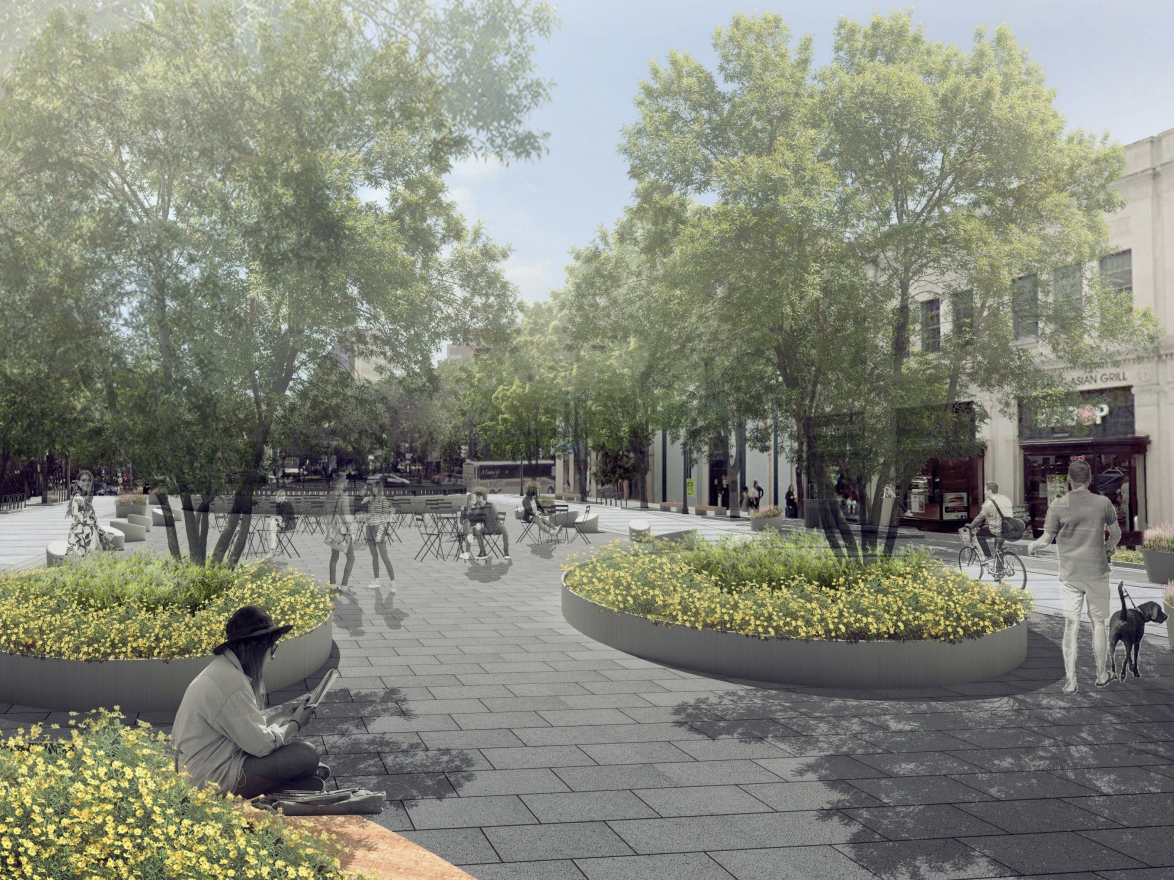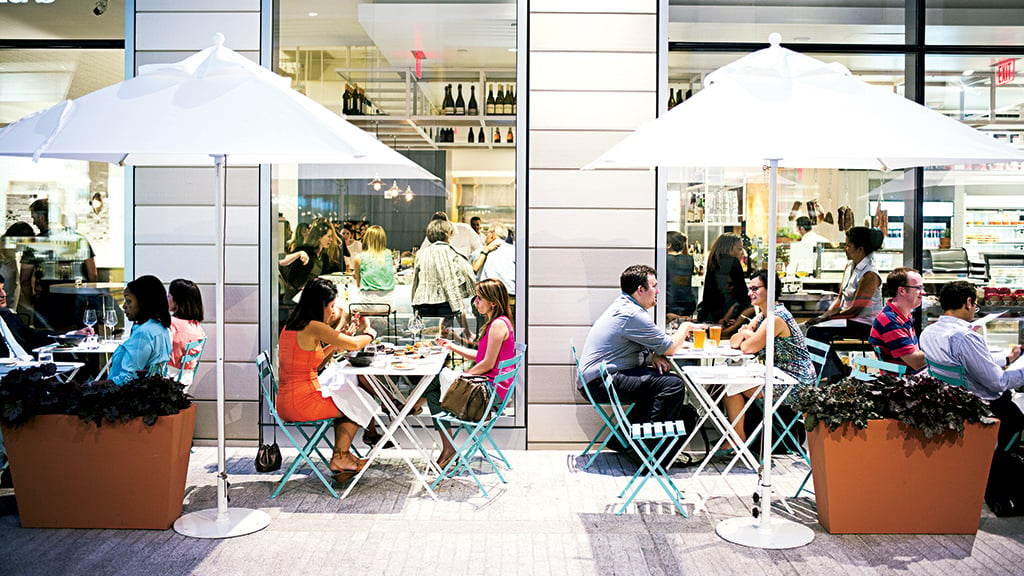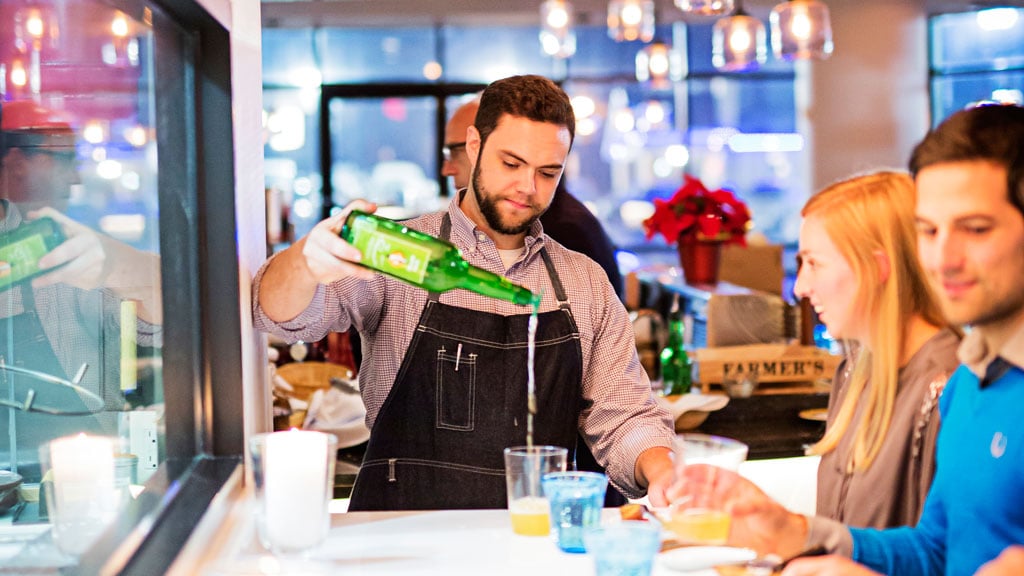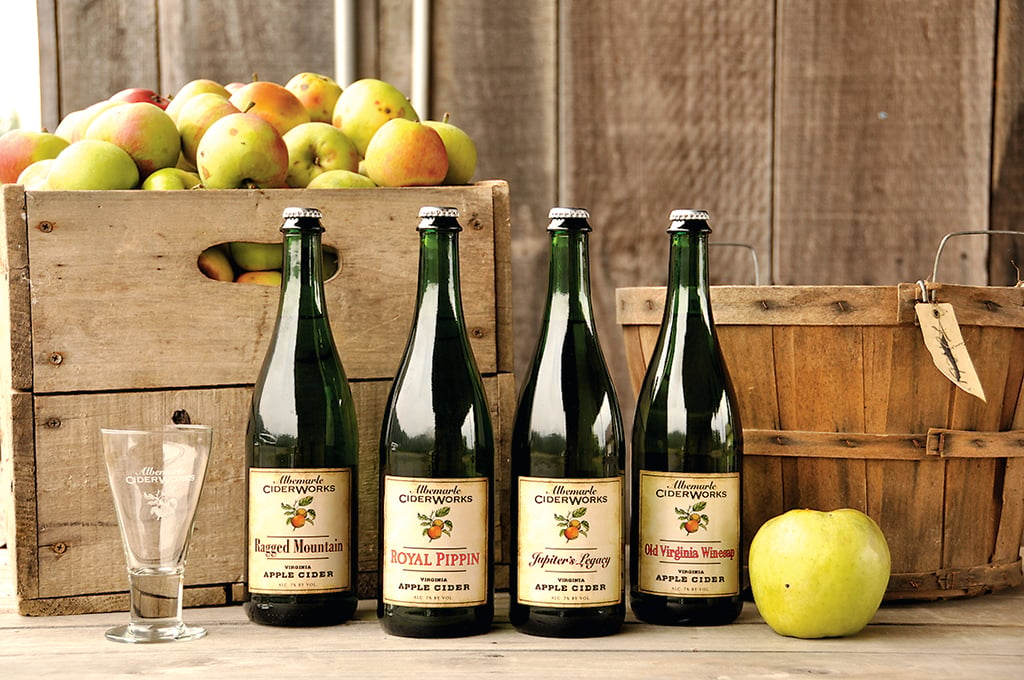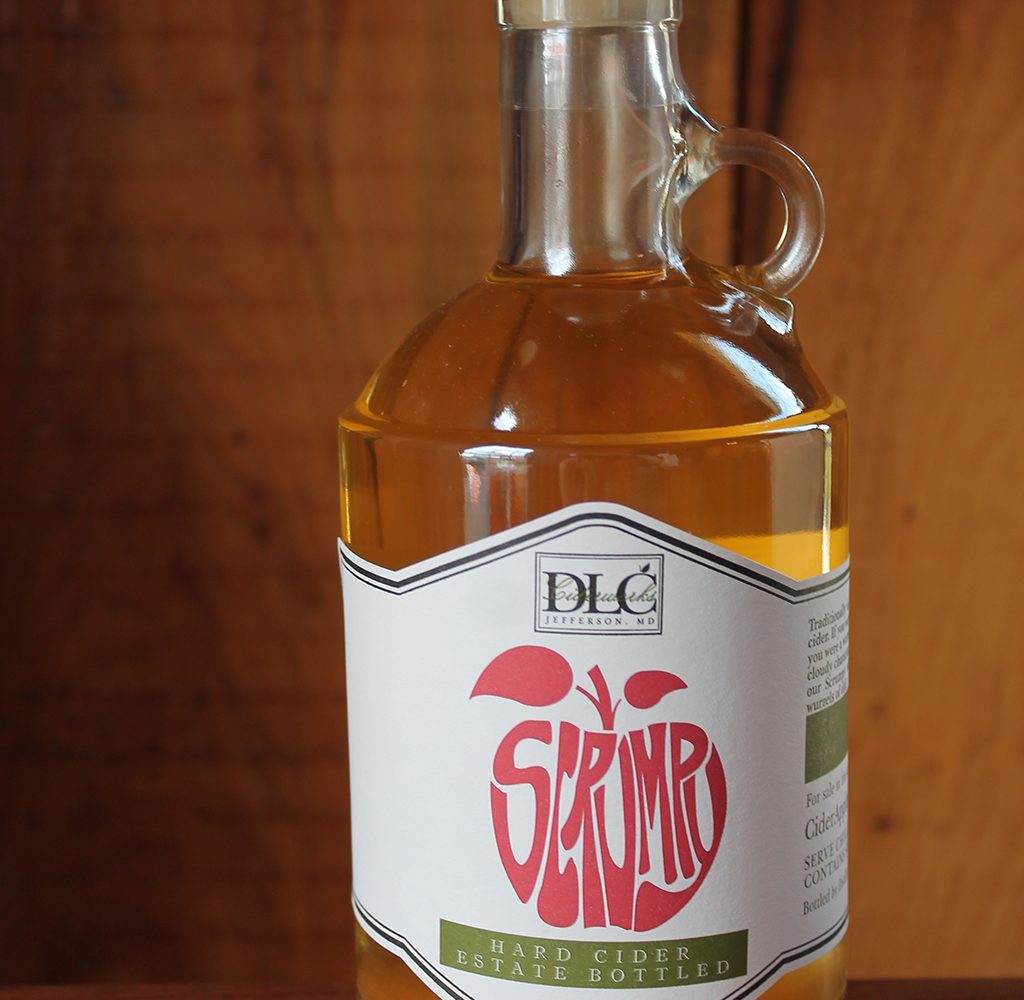Italian food in America was shaped by the immigrants who came from Naples and Sicily between 1880 and 1920, and life in America changed their cooking. In his book America Eats Out, John Mariani notes that though immigrants had been spending 85 percent of their incomes to feed their families in Italy, putting food on the table here required only half of their earnings.
In the Old Country, meat had been scarce and of poor quality. For the classic ragu alla Napoletana, a cut of tough beef or of fatty pork was simmered for hours with tomatoes, garlic, onions, carrots, and celery. When the meat had simmered to tenderness, it was put aside to provide the main course. The sauce it had flavored was used to lightly coat a course of pasta, which followed an antipasto of fresh and preserved vegetables. The stewed beef or pork was doled out in small portions so there would be enough left to stuff ravioli for the following day. Because meat was so dear, its consumption was a celebration, which is why ragu alla Napoletana was traditionally enjoyed on Sunday.
In America, the abundance of every sort of meat and its relatively low cost changed the diet of southern Italian immigrants. Sauce no longer had to be used sparingly on pasta. The single-meat Neapolitan sauce became an extravaganza of spareribs, pork rolls, meatballs, and sausages, which became known as “Sunday sauce” in the homes of the Neapolitan immigrants and as a “meat platter” in Italian-American restaurants.
Italian immigrants began opening restaurants in New York, and these early establishments set the style of cooking—Neapolitan, toned down to fit American tastes. A number of peculiarities set it apart from traditional Neapolitan cooking.
Neapolitans prefer commercially produced pasta to that made in-house, and they like it cooked al dente. But most Americans preferred their pasta softer, so precooking and reheating pasta became standard at Italian-American restaurants.
Despite its small Italian community, Washington did not lag far behind New York in getting its own Italian-American restaurants. In 1920 the Roma opened at 3419 Connecticut Avenue, followed in 1922 by Ciro’s Famous Village Restaurant, at 1304 G Street, Northwest.
For almost 50 years, every Italian-American restaurant that opened in Washington followed the formula of pasta as a main course or tomato-sauced pasta as a garnish for the main course. Along the way, there were a couple of innovators: In 1943 Luigi’s, in downtown DC on 19th Street, introduced pizza to Washington. In 1949, Augusto Vasaio made pizza bianca—a crisp, thin pizza without tomato or cheese, topped with garlic, oregano, and hot-pepper flakes—a staple of his A.V. Ristorante Italiano on New York Avenue.
Italian-American fare became the most popular ethnic food in Washington. In the mid-1930s, an Italian-American menu would list fettuccine with meat sauce for $2.25 and a veal chop pizzaiola for $2.50. Add a dollar to those prices and that is what the same dishes sold for at Luigi’s, Marrocco’s, and Gusti’s, all popular Italian-American restaurants in 1960s Washington.
But then Washington experienced a boom in French restaurants. Italian-American restaurants continued to be popular, but their bargain-priced cucina lacked the cachet of haute cuisine. In the Washington of the 1960s, serious dining meant a French restaurant.
That began to change on January 3, 1968, when Joseph Muran de Assereto opened Cantina d’Italia, a basement restaurant of 75 seats on the corner of Connecticut Avenue and 18th Street. Cantina started with three advantages: It approached Italian food as something to be taken seriously; it charged prices comparable to those of the best French and Continental restaurants; and it had Joseph Muran de Assereto in the dining room.
De Assereto was the greatest menu pitchman the city had ever seen. Cantina’s handwritten menu, which changed frequently, was barely legible, and most of its dishes were unfamiliar to its clientele. De Assereto had a welcoming presence that made diners feel at ease; his warm baritone made the menu’s mysteries sound mouthwatering; and he was able to convince patrons that an unfamiliar dish was irresistible.
But what most endeared customers to Cantina d’Italia was de Assereto’s passionate belief that arrogance had no place in restaurants. This was a refreshing attitude in the 1960s and ’70s, when waiters in French restaurants could be counted on to treat diners who were not regulars with disdain. Cantina’s menus promised that any dish not to a patron’s taste would be replaced by another.
For the first few years, de Assereto hedged his bets by offering dishes both from the Italian-American repertory and from the regional cuisines of northern Italy. Diners could find comfort in fried mozzarella, fettuccine Alfredo, and veal Marsala, while those who followed Joseph’s counsel discovered the delights of fresh pasta tossed with sweetbreads, stewed rabbit, and creamy polenta topped with house-made sausages.
By 1974, the preponderance of dishes on Cantina’s menu were from northern regional cuisines, so Cantina d’Italia could claim to be our first authentic northern Italian restaurant. Cantina’s French competitors offered unchanging menus and a few daily specials. To expand his patrons’ tastes, de Assereto offered a new menu every four or five weeks.
Cantina d’Italia got its first upscale Italian competition in 1975, just five blocks away, on K Street, from Giulio Santillo, a young Neapolitan who had graduated from culinary school in Italy and worked in such great European hotels as the Crillon in Paris and Claridge’s in London. Santillo’s restaurant, Tiberio, was located between Jean-Pierre and Le Bagatelle, the two hottest palaces of haute cuisine in town.
With its whitewashed walls, graceful archways, and crystal vases filled with long-stem roses, Tiberio had the look of luxury. Santillo, who had worked as a croupier in a Bahamas casino, gambled that Washingtonians would equate high prices with high quality: His prices sometimes exceeded those of his French competitors, while, thanks to $16 and $18 plates of pasta, which many of his patrons ordered as main courses, his food costs were lower.
Santillo rubbed his high prices in his customers’ and competitors’ noses: In a half-page ad in The Washingtonian, most of the space was filled with a repetition of the word “very,” ending with the word “expensive” and the tag line “But worth it.”
Tiberio did not put Cantina d’Italia out of business. It did, however, put the fear of God in Joseph Muran de Assereto. Because the Cantina’s cramped premises could not compete with Tiberio on the basis of looks, de Assereto resolved to stake Cantina’s position as Washington’s leading Italian restaurant on the uniqueness of his dishes and the quality of his cooking. He began changing his menu every two to three weeks, relying on classics from Italy’s northern regions plus a couple of his own improvisations, like Spaghettata Cantina, a dish of house-made tomato pasta and spinach pasta tossed in a torrid tomato sauce and garnished with hot sausages.
Cantina d’Italia averaged 300 patrons a day in its dining room of 75 chairs. But no one came along to copy it—it was too much trouble: Why expend the effort to sell fettuccine with a sauce of sweetbreads and fresh sage leaves when fettuccine Alfredo sells itself and makes more profit?
Giulio Santillo promoted Tiberio as a northern Italian restaurant, but in fact it was a grab bag of Neapolitan and Italian-American standards—roasted peppers with anchovies; steamed mussels with tomatoes; fried mozzarella—and Continental dishes borrowed from hotel dining rooms, such as Veal Scallops Zingara, though the chopped black truffles—the most expensive ingredient of a classic Scaloppine alla Zingara—were absent.
Santillo was a good salesman: He convinced his patrons that northern Italian food was sauced with cream, as his agnolotti were, and southern Italian food was sauced with tomatoes—though tomatoes appear in many dishes traditional to northern Italy. The menu at Tiberio represented sophisticated northern Italian dining in the public’s imagination, and it was freely borrowed from by the restaurants that soon followed: Il Giardino, Leonardo Da Vinci, Geranio, and Giorgio’s.
By the end of the 1970s, Cantina d’Italia and Tiberio had elevated Italian cuisine to the level formerly held by French restaurants. The French lost none of their popularity; Le Bagatelle and Le Lion d’Or were packed with business lunchers and remained the top choices for special occasions. Cantina d’Italia—with bestsellers like its gnocchi with pesto, tomato-sauced chicken with sausages, and a crumb-covered veal chop stuffed with Fontina cheese and prosciutto—remained Washington’s only authentic northern Italian restaurant.
In the spring of 1980, Vince MacDonald opened Vincenzo near the corner of 20th and Q streets. MacDonald was a free-spirited college dropout who had worked as an elevator operator in Congress, as a waiter in an Italian-American restaurant in Bethesda, and as a bartender in one of Georgetown’s first French bistros, Au Pied de Cochon. He fell in love with Italian cooking when a friend took him to A.V. Ristorante Italiano, where he learned to ignore the menu and rely on owner Augusto Vasaio to steer him to the kitchen’s best dishes.
In 1972, when MacDonald was a waiter at Pines of Rome in Bethesda, he started studying Italy’s regional cuisines, guided by Waverley Root’s The Food of Italy. In 1977 MacDonald went to Italy on a three-week vacation. The meals he ate there not only fleshed out Root’s prose but also supplied the ideas for the restaurant MacDonald was resolved to open.
From its stark-white, stuccoed walls and terra-cotta-tiled floors to its all-seafood menu and gratis bottles of sparkling Italian water, Vincenzo was an Italian restaurant the likes of which Washington had never seen. The incongruity between a setting resembling a Florentine trattoria and a menu that might have come from a seafood restaurant on the outskirts of Rome was an accident: MacDonald had intended to offer a meat-heavy menu borrowed from some of his favorite restaurants in Florence, but at the last minute he decided on an all-seafood menu.
Vincenzo was an overnight success: MacDonald’s purist approach attracted a clientele of Italian expatriates, diplomats, and Italophiles. Critics who found fault with Cantina d’Italia’s oversauced pastas and Joseph Muran de Assereto’s penchant for boosting the flavor of dishes with Old Bay seasoning delighted in MacDonald’s devotion to authenticity.
His pastas were tossed with a spare amount of their sauces. The tuna steak, grilled rare, made its Washington debut at Vincenzo. Until Vincenzo, no restaurant in Washington offered whole fish, such as sea bass or striped bass, cooked on the grill.
Besides the authenticity of its fare, Vincenzo contributed a sense of casualness to Italian dining. Tiberio and Cantina were coat-and-tie places with high prices. Vince MacDonald, a sandals-with-socks kind of guy, cared more about his customers’ appreciation of authentic Italian food than about the cut of their suits.
In 1984, Savino Recine and Roberto Donna took over Torremolinos, a popular Spanish restaurant that had allowed its lease to expire. Its sub-sidewalk dining room on P Street was a two-block walk from Vincenzo. The two partners, who had met while working at Romeo and Juliet, a K Street Tiberio wannabe, intended their little restaurant of 50 chairs to be a reasonably priced trattoria featuring northern Italian cooking.
At first glance, Recine and Donna were a dream team: an elegant, experienced front-of-the-house man working with a talented young chef. They christened their restaurant Galileo—after the 16th-century astronomer accused of heresy for postulating that the earth circled the sun—and set out to offer authentic Italian cooking with a market freshness then unknown to Washington or anywhere else in the country.
Inspired by the rural restaurants in Italy at which the proprietor recited a menu of dishes determined by the daily market, Donna composed his lunch and dinner menus largely anew each day. Galileo, like Vincenzo, was an instant hit.
The moment that defined Galileo as Washington’s hot new restaurant came in its first year, when it received a request for a reservation from the office of then-Vice President George Bush. The restaurant was booked to capacity, and Savino Recine couldn’t figure out how to displace a table of customers to accommodate him. He let the press know that his restaurant was so popular it couldn’t squeeze in the Vice President; the publicity made a reservation at Galileo even harder to come by. Eventually, Vice President Bush dined at Galileo with fellow former UN ambassador, John Scali.
In time Galileo became so solidly booked that Recine and Donna felt comfortable raising their prices 50 percent: The three-course lunch with wine, tax, and tip that cost a bargain $60 rose to $90. But Recine and Donna still wanted a popularly priced authentic Italian restaurant. The result, three years after the opening of Galileo, was Primi Piatti, a Foggy Bottom restaurant with a sumptuous display of antipasti, DC’s first wood-burning pizza oven, and affordable prices. It was another success.
But Recine and Donna were a vinegar-and-oil partnership that soon separated. Recine got the capacious Primi Piatti, Donna the tiny Galileo. Donna soon opened a trattoria of his own, the airy i Matti in Adams Morgan, where he offered a slightly different version of the moderately priced menu he had composed for Primi Piatti but, because of a noncompetition agreement with Recine, no pizza baked in a wood-fired oven.
In the mid-1980s, across P Street from Galileo, yet another authentic Italian restaurant opened. Set on the second floor of a 19th-century rowhouse, Obelisk was an elegantly spare trattoria of 30 chairs, its walls accented by a few framed architectural etchings. It was—and remains today—unique among Washington’s Italian restaurants. Owned by Peter Pastan, a young Marylander who went to Italy to pursue his interest in wine and ended up working in a small restaurant, Obelisk was as pure in its pursuit of authentic Italian cooking as Vincenzo.
Unlike the rural Italian restaurants it was patterned on, Obelisk offered a written menu—a five-course, fixed-price dinner with three or four dishes to choose from for each course.
It seemed destined for failure: It was too small, it was open only for dinner, you could not go expecting to find a favorite dish on the menu, and the meal was a fixed price. Two decades later, Obelisk’s longevity bears out the wisdom of Pastan’s concept: a dining room whose limited seating allowed for custom-cooked dishes made with the best available ingredients, and a fixed-price menu that made it easy to control costs.
Pastan could dazzle with something as simple as a plate of fresh fettuccine tossed with butter, a handful of locally grown English peas, and a spare sprinkling of freshly grated Parmesan. The best possible ingredients in ideal proportions embodied the triumph of authentic Italian cooking: the ability to make something memorable out of seemingly nothing much.
Today Obelisk is known nationally as one of Washington’s top restaurants. Even for a Tuesday or Wednesday night, it takes a call made four to five days ahead to secure a reservation. Not bad for a little Italian place of some 30-odd chairs.
At the end of the 1980s, Galileo moved from its P Street home to the expansive 21st Street premises formerly occupied by Il Giardino. But even as popular as Roberto Donna had become, his move was eclipsed by the opening of an import from Florence called i Ricchi.
Located across 19th Street from the Palm, Washington’s reigning power-lunch restaurant, i Ricchi was so wonderful at the outset because it was so naive: Chef/proprietor Francesco Ricchi and his American wife, Christianne, who had both worked at the Ricchi family restaurant outside Florence, were so convinced of the appeal of their regional cuisine that they saw no need to adjust it to suit American tastes.
They were right: Their house-baked breads were better than what local boutique bakeries sold; their meat sauces were dark and concentrated in flavor; their classic Florentine roast loin of pork, redolent of garlic and fresh rosemary, was a new pleasure for Washington diners; and their signature dessert of concrete-hard biscotti, meant to be soaked to chewability in a glass of Tuscan vin santo, provided a light finish.
The restaurant’s cachet got a boost after President George H.W. Bush’s inauguration when Victor Gold, coauthor of the new president’s autobiography, hosted a dinner party for the new First Couple at i Ricchi. In those days, presidents rarely dined in public, so the visit drew the attention of the press. A month old, i Ricchi was the city’s hot new restaurant.
The revolution in Italian restaurants that Vince MacDonald began at Vincenzo came to full fruition in the 1990s. Joseph Muran de Assereto, the pioneer, sold the Cantina and retired. Without him, the restaurant lost its appeal and soon closed.
Thirty years after President John F. Kennedy’s taste for fine French cuisine launched Washington’s golden age of formal French restaurants, those establishments—even the best of them—now seemed too stiff, too formal. The city’s finest classic French restaurant, Le Lion d’Or, where once you had to make reservations days ahead to secure a table for lunch, now barely filled half its dining room from noon to 2 pm. Call i Ricchi for a lunch table and the voice on the other end would offer two choices, “11:45 or 1:45?”
French bistros that offered good cooking at fair prices were unaffected by the growing resistance to the expensive charms of the haute-cuisine palaces. Yannick Cam, one of the nation’s top French chefs, closed his first and second Le Pavilion in the 1980s. Since its opening in 1976, Le Lion d’Or had presented a classically long menu in French without English translations. Nobody complained. But by 1993, local diners had grown so averse to the customs of haute cuisine that some of the city’s finest French chefs presented menus written entirely in English: The first was two-star Michelin chef Gerard Pangaud at Gerard’s Place; he was followed by Michel Richard at Citronelle and Jean-Louis Palladin when he opened his second restaurant at the Watergate, Palladin by Jean-Louis.
But grand dining in the French style was doomed. Le Lion d’Or—whose chef/proprietor, Jean-Pierre Goyenvalle, had helmed three of the best French restaurants of their time, including Rive Gauche, and Jean-Pierre, the first restaurant on K Street—closed. Jean-Louis Palladin, whose namesake nouvelle cuisine boutique in the Watergate never had a problem filling his 40 chairs, lost money because its food costs were too high. When new hotel ownership decided not to continue subsidizing Palladin’s restaurant, it was curtains for Jean-Louis.
Authentic Italian restaurants took over the fine-dining market. The kitchen at Galileo was the finishing school for the talent: The chef from just about every good Italian restaurant that opened here in the 1990s was a protégé of Roberto Donna’s.
The first was Enzo Fargione, Donna’s sous-chef at the original Galileo, who headed the kitchen at Donna Adele and later opened Barolo on Capitol Hill. Next was Carmine Marzano, who opened Luigino. Fabrizio Aielli opened incarnations of Goldoni, including the current one, Teatro Goldoni, at the same K Street address that once housed Tiberio. At the beginning of the 21st century, Cesare Lanfranconi left Donna’s service to open Ristorante Tosca.
In the 1990s Donna expanded his holdings to a group of restaurants aimed at making authentic Italian cooking affordable to everyone. I Matti, which he had opened in DC’s Adams Morgan in the 1980s, allowed a couple to enjoy dinner with wine for $50, including tax and tip. It partly owed its success to Galileo regulars who shuttled between the two restaurants. When Donna began raising his prices to take advantage of the deep pockets of the Galileo crowd, he started losing the neighborhood regulars.
Donna next went after the Italian-American crowd with pizzas cooked in a wood-burning oven and authentic Italian pastas at budget prices. The place was called Il Radicchio, and its formula was simple: The diner paid $6 for as many plates of spaghetti as he or she could consume, and an additional $1.75 to $3 for each boat of sauce, of which there were some 20 choices. Thanks to high-tech pasta-cooking machines, the spaghetti was always al dente, and many of the sauces were identical to the ones Donna served at Galileo and i Matti. A wood-fired rotisserie offered roast chicken and boned suckling pig. It was all so good and affordable that the place was full at lunch and patrons lined up at dinner.
Donna opened two more Il Radicchios, in Arlington and on Capitol Hill, with his former Galileo sous chef Enzo Fargione. In Chevy Chase DC, Donna opened Arucola—the first Roberto Donna restaurant to be greeted with hoots. Arucola featured what Donna called “Italian dim sum”—an ill-conceived concept in which a server hauled a red wagon laden with variously sauced pasta dishes around the dining room. By the time the wagon had traveled to the fourth or fifth table, the pastas had become clumped together. Donna soon discarded the concept.
This period of expansion included a joint venture with Jean-Louis Palladin—a tiny all-seafood trattoria/bistro on P Street called Pesce, whose menu and wine list were half Italian, half French—and Cesco, a Bethesda trattoria that Francesco Ricchi opened some years after his divorce forced him to leave i Ricchi. Donna always left his kitchen at Galileo in the hands of a talented sous chef able to maintain the quality of his authentic Italian cuisine.
Donna’s empire brought him a windfall of publicity, but not even Roberto Donna could find enough Italian chefs here with the dedication and talent to produce Donna-quality cooking in his subsidiaries. As the 1990s ended, Donna abandoned outside projects to concentrate on Galileo, which eventually would house three differently priced dining venues under one roof.
Roberto Donna had nothing to do with the opening of Bice, Washington’s hot Italian restaurant of 1991. A branch of a highly regarded Manhattan restaurant, it featured a luxurious setting by Adam Tihany, one of the nation’s leading restaurant designers. Its menu changed almost as frequently as Galileo’s, and its dishes, drawn from various regions of Italy, were traditional dishes given modern presentations.
Bice had a fast rise and fall once the corporate chef left to open branches in other cities. Now long gone, its lasting contribution to Italian dining in the capital was in bringing Franco Nuschese to Washington.
Nuschese came to Bice by way of Caesars Palace in Las Vegas, where he learned the art of the stroke—the ability to make every customer feel like a VIP. Soon what once had been a catch phrase for fine Italian dining, “Let’s go see Joseph at Cantina,” became “Let’s go see Franco at Bice.”
A year after managing Bice to popular success, Nuschese opened his own place in Georgetown, Cafe Milano. It was slickness incarnate, an Italian version of a Washington saloon with tables. Its floors were covered with glazed terra-cotta tiles, its walls were accented with framed silk scarves by Italian designers, and a map of the Milan subway system was painted on the ceiling.
It was a place where one felt equally comfortable making a quick meal of a plate of pasta or a composed salad and glass of wine or ordering a three-course meal with a good bottle of wine.
Cafe Milano was a high-energy social place that attracted a clientele of tycoons and politicos, Georgetown’s old guard and Georgetown University students, as well as celebrities from show business and sports. In its 13 years it has expanded into the city’s largest Italian restaurant through the addition of an enclosed dining terrace and several quieter dining areas sheltered from the hubbub of the main dining room and bar. The most attractive is a glass-enclosed dining room Nuschese built to accommodate Plácido Domingo, who on an initial visit to Cafe Milano told Nuschese he loved the food but could not abide the noise. Within a week, the area now known as the Domingo Room was enclosed, and the great Spanish tenor is Cafe Milano’s most frequently sighted celebrity.
In the mid-’90s, Nuschese tried to duplicate his Cafe Milano success by opening a restaurant in the former premises of Bice. Called Villa Franco, it was a sumptuously decorated place that introduced Washingtonians to the cooking of Nuschese’s native Amalfi coast. The kitchen was headed by Enzo Febbraro, whose contemporary presentations of classics from the region of Campania had all the flavor of the traditional preparations but were surprisingly light. A diner with a normal appetite could begin with a first course of eggplant alla parmigiana with Neapolitan ragu, comfortably finish a main course of poached striped bass, and still look forward to a Neapolitan dessert.
The faithful from Cafe Milano came in droves to Villa Franco, and though they loved the spaghetti alle vongole and the branzino all’aqua pazza, they missed the energy of the Georgetown place. After about a year, Villa Franco was history. Today the premises are occupied by Yannick Cam’s eighth Washington restaurant, Le Paradou.
The Italian equivalent of the French bistro is the trattoria, a small to medium-size restaurant with good cooking at moderate prices. In the last couple of years, both Roberto Donna and Franco Nuschese have begun exploring the trattoria-osteria concept. Donna’s osteria comprises a few tables set near Galileo’s bar where he offers a changing menu of antipasti, pastas, and main courses, all priced at $10 or less, and a small selection of bargain-priced wines sold by the bottle or the glass. Prepared by the same cooks who feed the high rollers in Galileo’s main dining room, such dishes as lamb stuffed with prosciutto and Fontina cheese and rabbit legs braised in red wine make Osteria del Galileo the metro area’s best value in authentic Italian dining.
Franco Nuschese is from the southern Italian region of Campania, whose most famous city is Naples, which claims to be the birthplace of modern pizza. Being passionate about authentic Neapolitan pizza is Nuschese’s birthright, and he wasn’t impressed with what he tasted in Washington: The dough had not been left to rise long enough; it was sweetened with honey; the crust was too thick; the toppings were too heavily applied; worst of all, the pies were undercooked. He was even critical of the pizzas he served at Cafe Milano because they were not cooked in a wood-burning oven. So he opened Sette Osteria in Dupont Circle to set things straight.
After a few months of inconsistent pies, he now can claim to serve the best authentically Neapolitan pizza in Washington. As for the rest of the menu, Sette Osteria could be called Cafe Milano Lite: antipasti, pastas, salads, main course and three daily specials, almost all drawn from the cooking of Campania. Except for the pizzas, Sette’s prices are half to a third of those at Cafe Milano.
In October Nuschese opened Sette Bello, a sleekly modern trattoria half a block from the Clarendon Metro station. The menu—composed by Cafe Milano’s executive chef, Domenico Cornacchia—is four times the length of Sette Osteria’s. Along with designer salads, pasta, an assortment of spectacular Italian cold cuts from New York, and a full complement of main courses, there is a page of “small plates,” served only at the bar, and a crudo station, which offers the area its first taste of Italian-style sushi. On the second Friday night after its opening, Sette Bello had served more than 500 dinner customers.
Moderately priced trattorie and osterie arguably represent the future of authentic Italian cuisine here. Moderate prices have been the secret of French bistros like Le Bistro Français and La Chaumière, which have had strong support from Georgetown residents for more than 30 years. The formula of neighborhood familiarity, casual comfort, and good value also has spelled success for the new generation of bistros, such as Dupont Circle’s Bistrot du Coin and Montmartre on Capitol Hill.
Good as their cooking may be, there now may be too many high-priced Italian restaurants on the local market, all sharing the same customer base. It won’t be a surprise if the next hot new Italian restaurant is a trattoria in an affluent neighborhood offering authentic Italian cooking at moderate prices by a recent graduate of Galileo’s kitchen.
And what about Vincenzo, the seminal force of the city’s authentic Italian-restaurant movement? It is still near the corner of 20th and Q streets, and it is still owned by Vince MacDonald. Every few years since its opening in 1980 it has changed its name, its format, and its prices. In the early 1990s it became the affordable Trattoria al Sole. Next it became an Italian steakhouse called Sostanza. The trouble with that idea was that Washington already had an Italian steakhouse—it was called the Palm—and nobody went to Sostanza.
On the brink of closing, MacDonald formed a partnership with Francesco Ricchi and rechristened the restaurant Etrusco. With Ricchi in the kitchen and MacDonald making frequent tours of the dining rooms, the restaurant attracted crowds. But then Ricchi and MacDonald had a falling-out over managerial styles and parted ways. MacDonald brought aboard peripatetic chef George Vetsch, whose many posts in local kitchens had included a stint at Vincenzo.
The menu is now composed daily, its prices are far lower than those at i Ricchi and Teatro Goldoni, and its fare is a mix of Vincenzo’s greatest hits—such as the splendid fisherman’s stew called brodetto—and forthright trattoria dishes such as roasted rabbit and sautéed veal cutlets veneered with prosciutto.
For the moment, it looks like Vincenzo/Etrusco is good to go for another decade and another name change or two.




